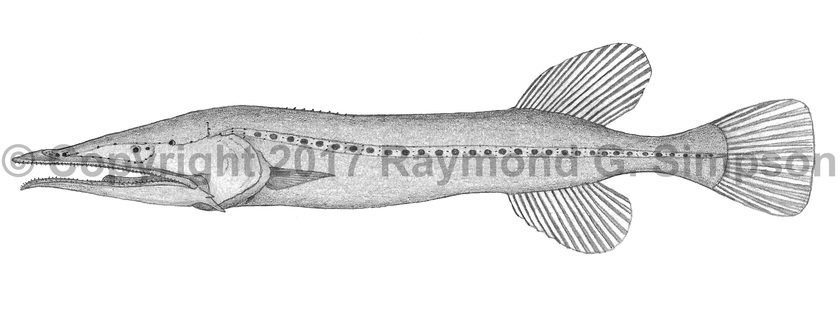
Common Name
Bird-snouted Whalefish
Year Described
Paxton, 1989
Identification
Dorsal Fin: 15-17
Anal Fin: 15-17
Pectoral Fin: 21-24
Lateral Line Pores: 31-40
Gill Arches: 3
Vertebrae: 43-45 (total)
Genus diagnosis after Paxton (1989) for females:
Head 20-30% SL. Body very elongated with a huge mouth (third of body length). Snout very long and pointed (twice in HL). Head very narrow. Upper jaw overhangs lower. Eye tiny. Nasal organ small. Jaws slightly convex to straight on upper and concave on lower. Three distinct gill arches with no slit behind last. Tooth plates separate. Lateral line relatively thin with round embedded scales and no obvious canal or raised rims. A vertical line of papillae between each lateral line scale. Large pores or cavernous tissue not present on head but reduced to scattered raised neuromasts. Additional neuromasts on lower jaw and snout. Teeth tiny and granular. Dorsal and anal fins located far back on body, with bases slightly elevated. Cavernous tissue absent. Sub-pectoral organ present. Caudal fin with 16 principle rays. Pelvic fin absent. Pectoral fin small and inserted low on body. Body flabby and scaleless except for diagnostic scales associated with the lateral line. Lappets of flesh around base of anal fin rays.
Males and juveniles unknown.
Color
Body of fresh specimens dark brown.
Size
Maximum size to 126mm SL.
Habitat
Bathypelagic between 1000-2100m.
Range
Known from two records in the Atlantic: one in the equatorial eastern Atlantic and another caught off the Bear Seamounts in the northwestern Atlantic (Moore et al., 2003).
References
Moore, J.A., K.E. Hartel, J.E. Craddock & J.K. Galbraith. 2003. An annotated list of deepwater fishes from off the New England region, with new area records. Northeastern Naturalist v. 10 (no. 2): 159-248.
Paxton, J.R. 1989. Synopsis of the whalefishes (family Cetomimidae) with descriptions of four new genera. Records of the Australian Museum v. 41: 135-206.
Other Notes
This genus is easily distinguished from all others by the very long snout. There may be two species represented in material according to Paxton (1989).